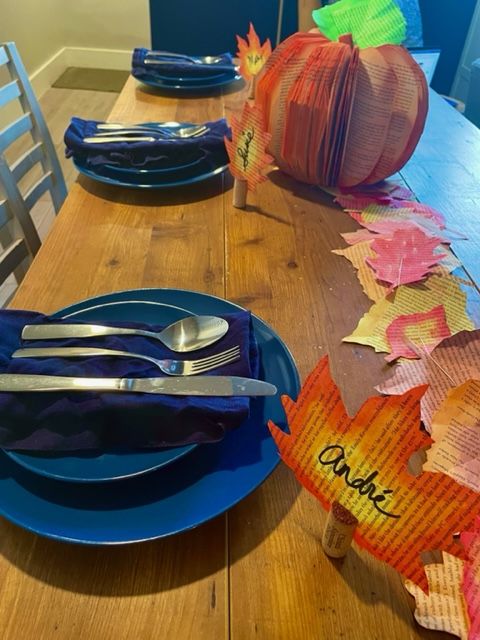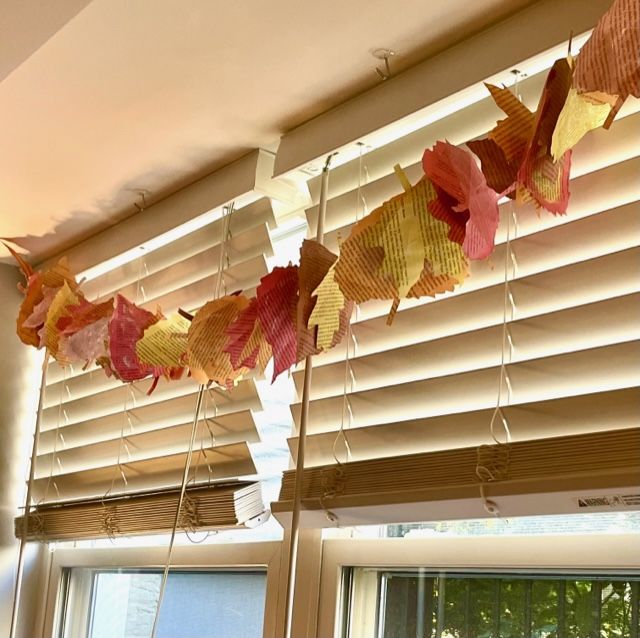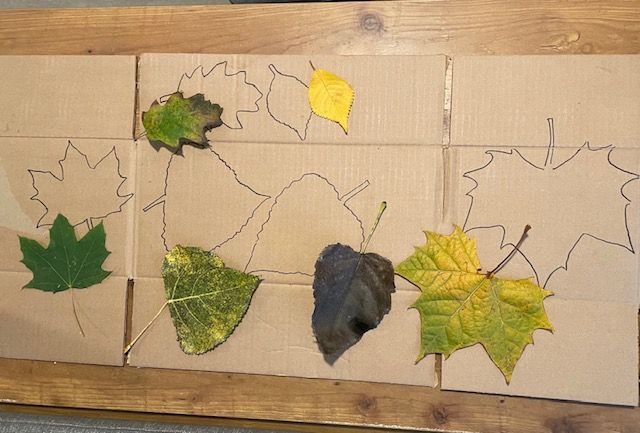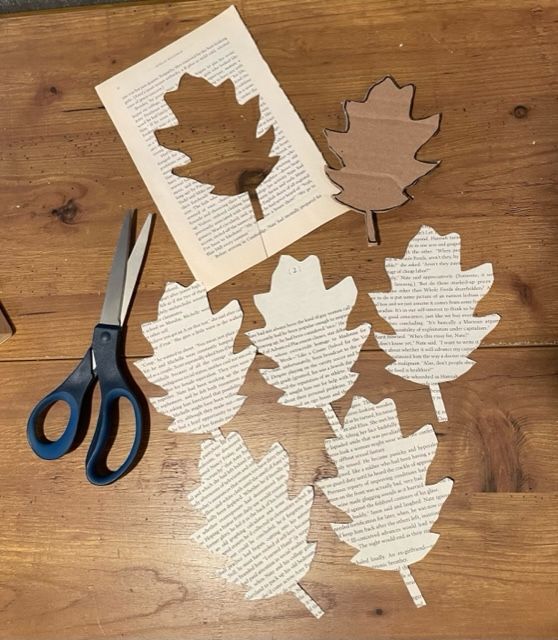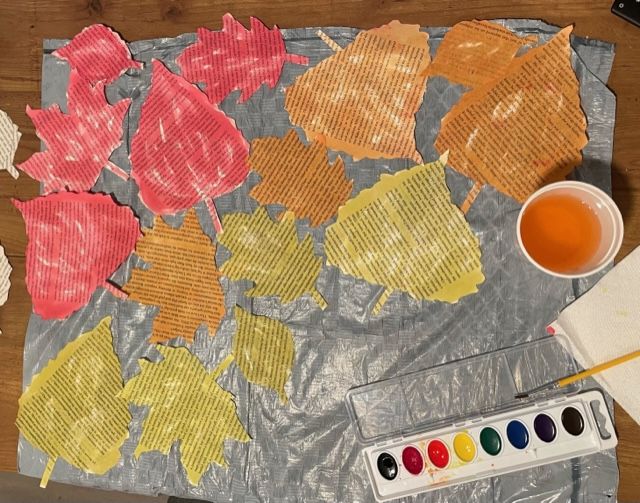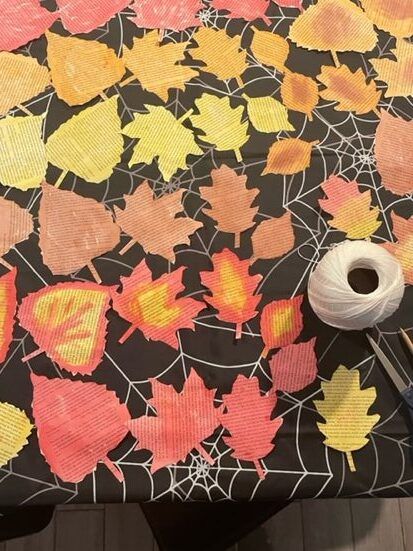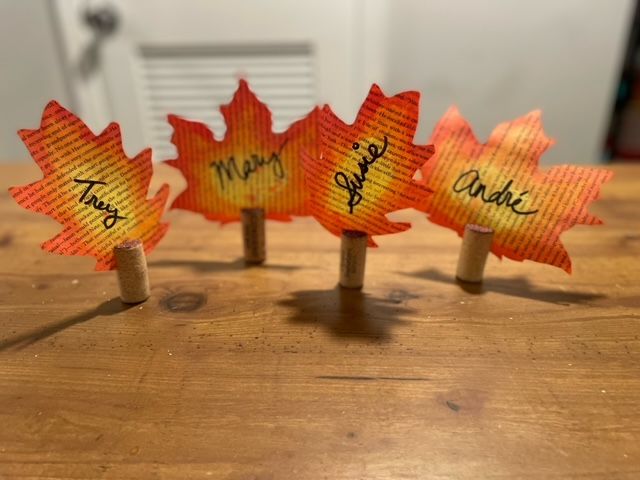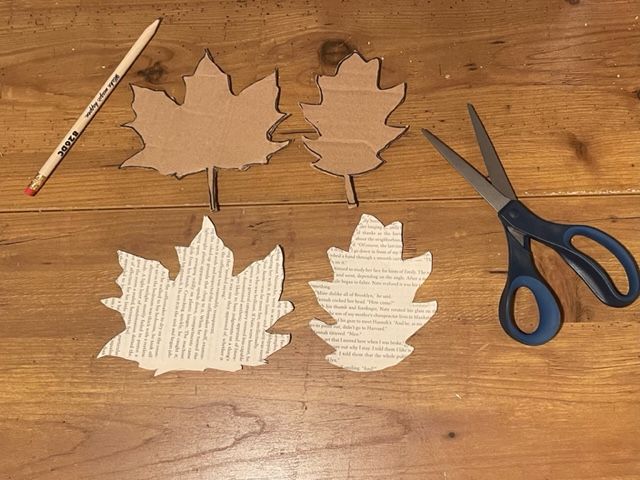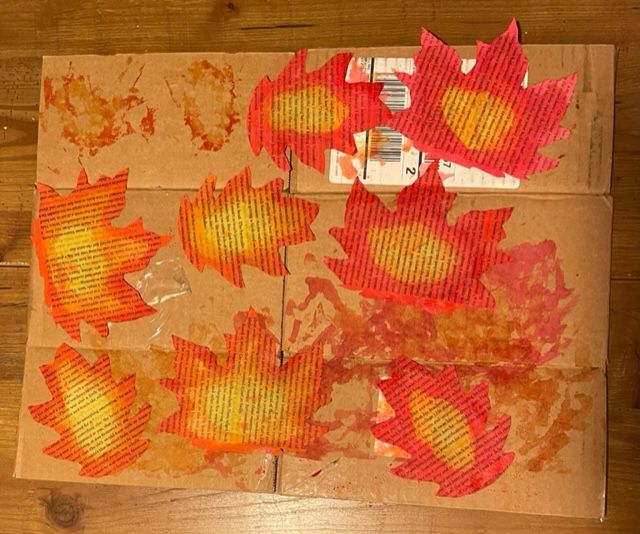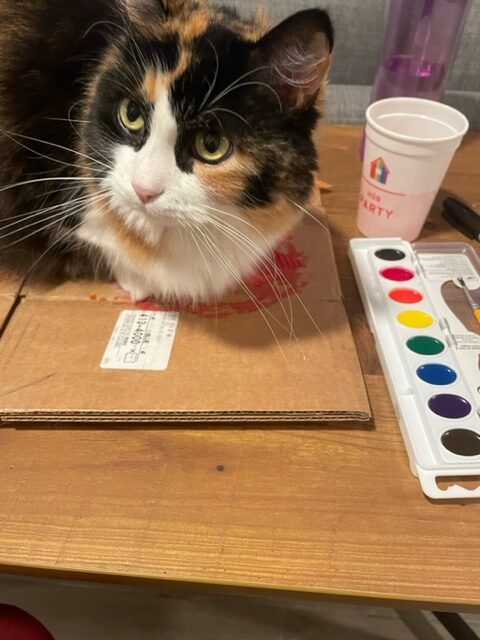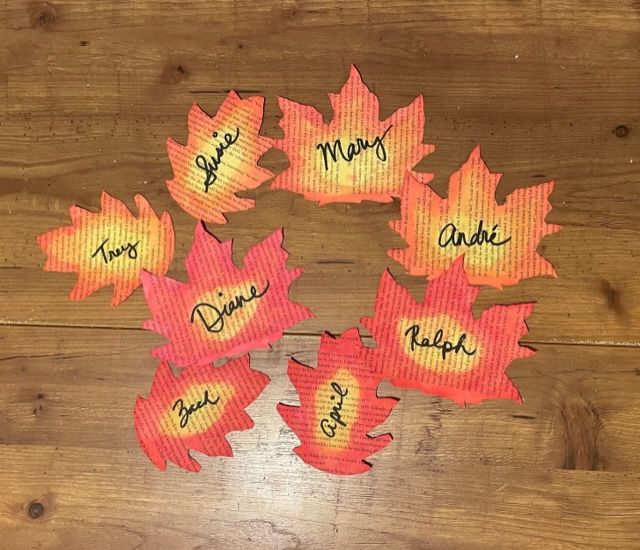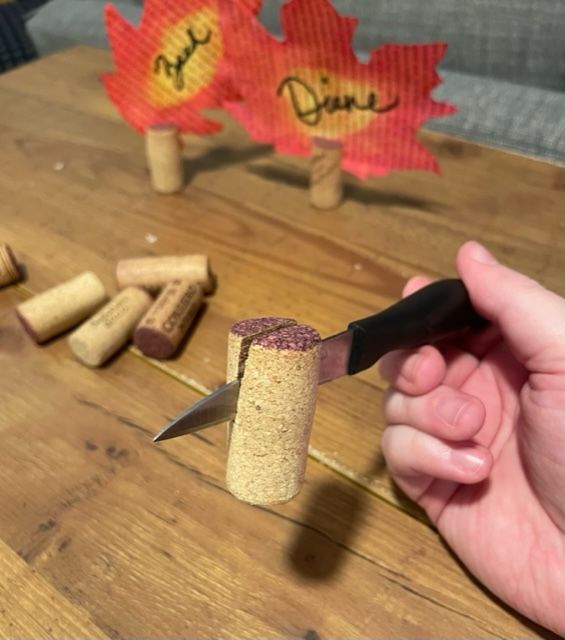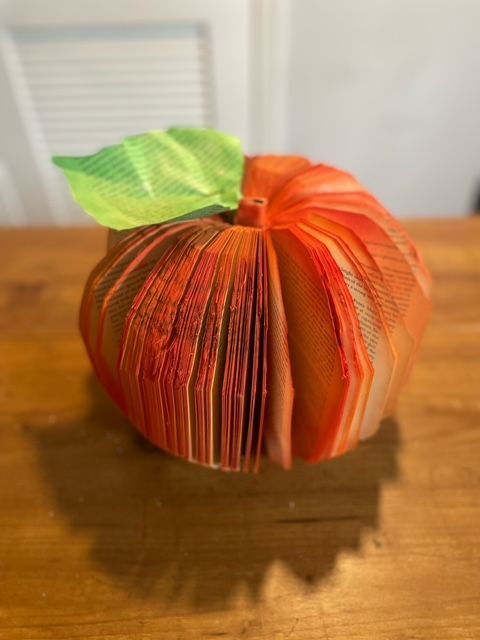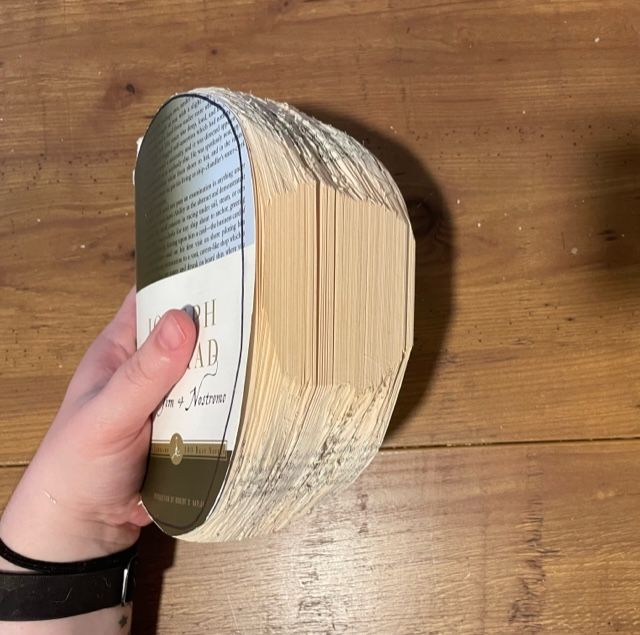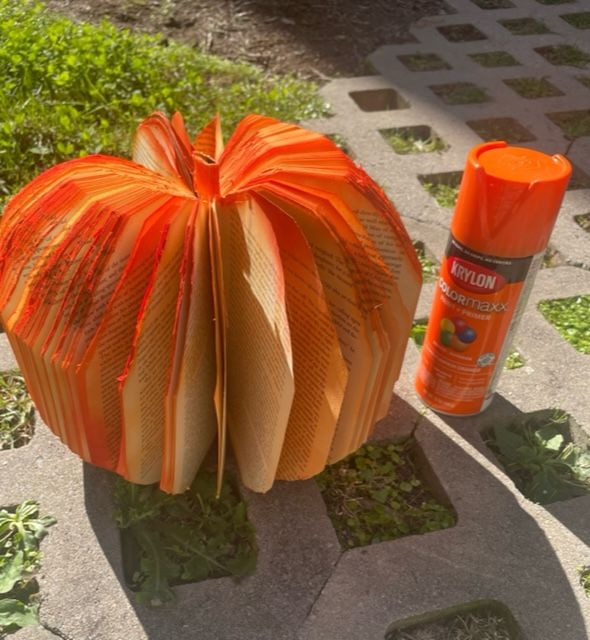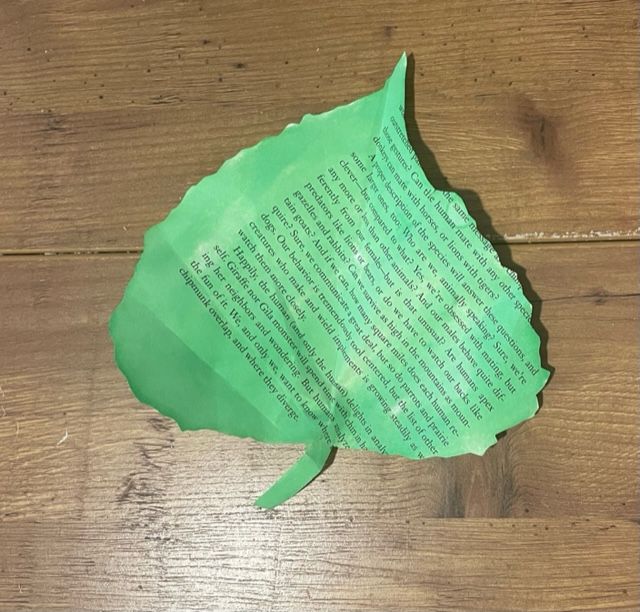A warning: These craft projects are all made using old books. If the idea of ripping up a book makes you feel squeamish, turn back now. But in my opinion, upcycling books is a great way of breathing fresh life into something that may otherwise only find its way into the dumpster. I found the three books I used for this project in a Little Free Library, and all of them had enough aging and water damage to make them unlikely candidates for finding readers. This way, they’ll be enjoyed in a new way rather than being thrown out or left to rot in Little Free Library space better reserved for less damaged books. Step 1: Make leaf stencils. I went on a walk in my neighborhood and picked up a handful of fallen leaves. You could also print off leaf outlines or freehand draw leaves. I personally like the more organic shapes from the real leaves. I traced the shape of the leaves onto cardboard and cut them out with a combination of scissors and X-acto knife. Cardstock would also work well in place of cardboard.
Cardboard or cardstock Leaves or printed outlines of leaves Marker, pen, or pencil Scissors or X-acto knife Old book Watercolor paints or other preferred paint Twine, string, or yarn
Step 1B: Remove cat from workspace (optional). You’re a book person, so this might be an important step for you too. Step 2: Trace stencils onto book pages and cut out shapes. With the older book I used, it was easy to rip out pages to make the shapes easier to trace. I ripped out five pages at a time, traced the shape with pencil, then cut the five pages in a stack to save on tracing and cutting time. Step 3: Paint leaves. This is the fun part! I painted the leaves with watercolors. They’re easy to find and cheap, and I like how the water aspect gave the book pages a wrinkly texture to make them look more like real leaves. I started off painting them one color each, but later experimented with mixing and blending colors. Anything goes here, which makes it an especially fun project with kids. They can get creative and later find their own artwork among all the leaves on the garland. Step 4: String leaves together with twine. I had white twine on hand, but a variety of twine or string or even fishing line would work here. Before stringing, I folded the leaves down the center and gave them some additional folds to have a more leafy texture. Then I pierced each leaf roughly through the center using a sharp pencil and strung them on the twine. Finally, I tied large knots on each end of the garland to keep the leaves from falling off. Done! Step 1: Follow steps above to make leaf stencils and cut leaves from book pages. If you’re also making the garland, then you’ve already done most of the work here!
An old book Cardboard or cardstock Scissors or X-acto knife Pencil or pen and black permanent marker Watercolor paints or other preferred paints Wine corks (optional) Sharp knife (optional)
Step 2: Paint leaves. I again used watercolors for ease and texture. In this case, try to keep a lighter color in the middle of the leaf where you plan to write the name so it will be easier to read. Step 2B: Remove cat from workstation (optional). This step is especially crucial if you’re working on a rectangular shaped piece of cardboard or paper, because you know they can’t resist it. Step 3: Write names of guests. I used a thick black Sharpie marker and wrote in my best cursive. Bonus points if you’ve got any calligraphy skills! Step 4: Cut wine corks. Using a sharp knife, carefully cut into wine corks from the round end to almost halfway down the length of the cork. This creates an easy and cheap stand to set the leaves upright. Once you slide a leaf into the cut in the cork, you’re done! Step 1: Trace half pumpkin shape on paperback book cover. I started out printing an outline of a pumpkin as a guide, but I ultimately ended up free-handing the shape. If you’re not using a jigsaw, you will also need to trace the shape onto the back cover. I cut out the shape on the front cover and folded the book down the middle so I could trace the same shape onto the back cover.
Paperback book Permanent marker or pen Scissors, an X-acto knife, or a jigsaw Hot glue gun Orange spray paint Green painted leaf (optional)
Step 2: Cut all pages of book to traced shape. This was the hard part. I used a combination of scissors and an X-acto knife to cut about five pages at a time. It was time consuming, imprecise, and left a lot of tiny pieces of paper on my workspace. That’s why I’d recommend using a jigsaw to get a cleaner cut, if you have one available. But fear not: the final product still ended up looking great, even though I was worried about my messy cutting job at this stage! Step 3: Hot glue covers together and fan out pages. I used the hot glue gun not only to glue the front and back cover together; I also used hot glue at random pages throughout to encourage the whole thing to fan out. I was able to keep the top of the spine intact, so I glued the edges of that together to create a stem. It would be easy to add cardboard or construction paper for a stem if that doesn’t work out with your book. Step 3B: Avoid hot gluing cat to book (optional). If yours is like mine, they will be curious about what you’re up to and try to get in the way. Step 4: Spray paint outer edges of book orange. You don’t need to douse the whole book in paint; focus on the edges of the pages, the top, and the bottom. Make sure to spray paint outside in a well ventilated area, and let it dry thoroughly. Step 5: Make green leaf (optional). I had a spare leaf from my other projects, so I watercolored it green, folded it to give it texture, and tucked it on top. You could also do this with construction paper. Stick that sucker on top and you’re done! Hopefully these bookish crafts inspired you to get creative with your old and/or damaged books! You might also enjoy: Bookish DIY Kits to Buy and Make for Holiday Gifting 8 Fun TikTok Bookish DIYs How to Make Bookmarks in Canva
